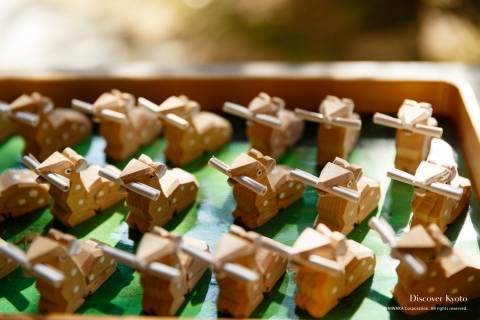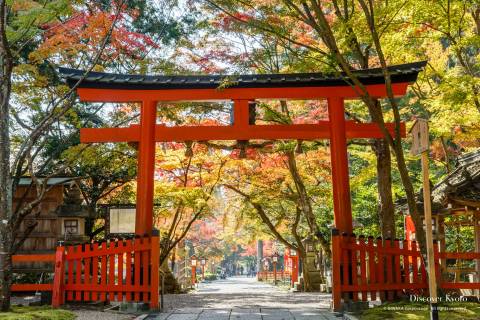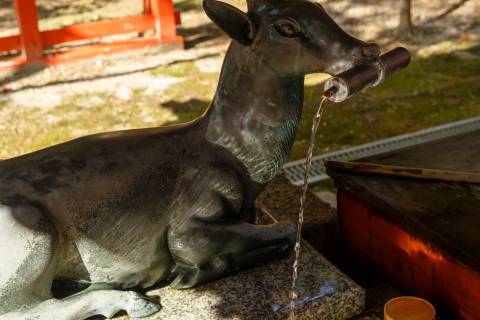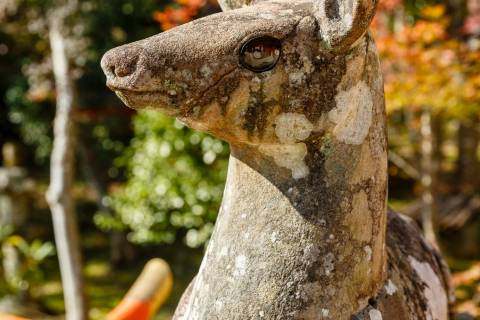Ōharano Shrine|大原野神社
Overview

Located in Kyoto’s southwestern and somewhat rural Rakusai area, Ōharano Shrine is a branch shrine of the famous Kasuga Taisha in Nara. Historically, Kasuga shrines have a strong association with the Fujiwara clan that dominated imperial politics in Japan’s medieval period. Because Kasuga shrines worship the Kasuga Daimyōjin deity, who is traditionally depicted astride a white deer, Ōharano Shrine is known for its deer imagery, including two stone deer that serve as guardians of the shrine’s prayer hall. This shrine is particularly lovely in the fall season, and also has two mugwort dumpling shops on the grounds that make delicious sweets.
Features
Prayer Hall & Main Hall

Ōharano Shrine’s main hall, flanked by two guardian deer statues, is a classic example of vermilion shrine architecture set against an impressive backdrop of tall cypress trees. Located at the end of the sandō entrance path and up a small flight of stairs, the main altars for the enshrined deities are half hidden within the fenced structure of the prayer hall. The main hall and auxiliary shrine at Ōharano Shrine enshrines the syncretic Shinto/Buddhist deities that make up the Kasuga Daimyōjin conglomeration, including: god of thunder Takemikazuchi no Mikoto, Iwainushi no Mikoto, Ame no Koyane no Mikoto, and Himegami in the main hall, with Oshikumune no Mikoto in the auxiliary shrine.
Ōharano Shrine is particularly known for success with prayers related to governance, directional luck, and knowledge. For the single ladies, it is also known as a guardian of women who grants them suitable partners in love.
Deer Messengers

Kasuga Daimyōjin is often depicted in art riding on a sacred deer, as he was said to have appeared before an ancestor of the Fujiwara clan in a vision. Deer were associated with the deity and considered to be his sacred messengers, thanks also in part to the fact that Nara, where the head Kasuga shrine is located, is heavily populated with deer who have flourished because of this religious belief. Due to this connection, the two stone guardian statues at Ōharano Shrine that flank the shrine’s main hall are a male and female deer in place of the usual lion dogs (komainu). Deer are also depicted on the shrine’s ema (votive tablets), the omamori amulets, the omikuji fortunes, and in a cuter style as a pair of votive bells, all available at the shrine’s reception area.
Fall Colors

Though Ōharano Shrine is also lovely when the trees are fresh and green, it is said to be most beautiful in the fall season when the maples of the surrounding forest begin turning brilliant shades of red, orange, and yellow. In particular, the small pond on the grounds and the entrance path between the shrine’s two torii gates are popular photo spots in autumn.
Local Treats

On the shrine grounds you can find two small shops run by locals that offer a selection of tasty treats, specializing in mugwort dumplings. Since the shrine is located in a more rural area, why not grab a snack before you head back home? One shop, Kasuga no Chaya, calls theirs yomogi dango. More modern dango are usually served three to a stick, but this traditional sweet, recipe unchanged since the Edo period, is served individually, with a geometric pattern pressed into the soft rice paste coating the red bean and kinako powder sprinkled on top. At the other shop, Kobayashi, they call theirs kusa mochi. Both mean mugwort dumplings, in the end, but you may have fun comparing flavors!
History
Ōharano Shrine’s history begins with Kasuga Taisha, the head Kasuga shrine located in Nara, known as Heijō-kyō back in the 8th century when it served as the capital. Supported by the politically powerful Fujiwara family and enshrining Kasuga Daimyōjin, a syncretic Shinto/Buddhist conglomerate of five deities, Kasuga Taisha grew quite influential and carried out prayers for the prosperity of the country and the imperial family.
Ōharano Shrine was founded in 784 on the occasion of the moving of the capital to Nagaoka, an area southwest of the current Kyoto city, in order to transfer the guardian deity of the Kasuga clan for convenient worship in the new capital. As the first branch shrine of Kasuga Taisha, it served the same duty of carrying out prayers for the country’s prosperity, and continued to do so even after the capital was moved again to Kyoto (then called Heian-kyō) in 794. It was one of the 22 shrines designated in the Heian period to receive offerings from the imperial court, and received the nickname “Kasuga Shrine of the Capital” (Kyō no Kasuga).
In 850, Emperor Montoku, whose grandfather was Fujiwara no Fuyutsugu, the well-renowned and influential head of the Fujiwara clan, ordered grand buildings be erected at the Ōharano Shrine. It became a tradition in the Fujiwara clan to pray for newborn daughters there so that they may be chosen as empress or imperial consort, and to hold grand processions and celebrations should they ascend to such social status later in life. In 1005, when the daughter of Fujiwara no Michinaga, Empress Shōshi, made pilgrimage to the shrine, it was recorded as a particularly illustrious procession. She was also said to be accompanied by lady-in-waiting Murasaki Shikibu, herself a distant Fujiwara relation and the authoress of The Tale of Genji.
In addition to the novel The Tale of Genji, Ōharano Shrine is also mentioned in numerous historical records and poems. The Heian period courtier and waka poet Ariwara no Narihira was said to have accompanied the wife of Emperor Seiwa, Fujiwara no Takaiko, on a pilgrimage to Ōharano Shrine when her husband was yet crown prince, and composed the following poem in offering.
The mountains of Ōharano and Koshio,
On this day to see the grandeur of our procession,
Must recall the age of the gods themselves
Events
Second Sunday in September | Mitakari-sai |
|---|
Access
Address
〒610-1153 京都市西京区大原野南春日町1152
| TEL | 075-331-0014 |
| FAX | 075-332-1977 |
| WEB | http://oharano-jinja.jp/ |
Admission
- General Admission: Free
Hours
- General Admission: 09:00 – 17:00
- Closed: Never
Transportation
Gallery
-




 +16
+16
